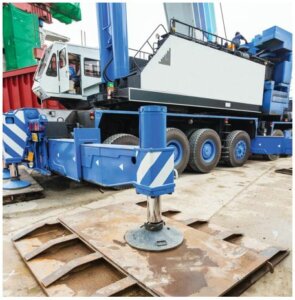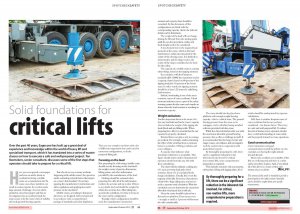
Solid foundations for critical lifts
Over the past 40 years, Eager.one has built up a great deal of experience and knowledge within the world of heavy lift and specialized transport, which it has translated into a series of master classes on how to execute a safe and well-prepared project. Ton Raemakers, senior consultant, discusses some of the first steps that operators should take to prepare for a critical lift.
Have you ever opened a newspaper and seen an article about an accident involving a mobile crane on a construction site? In some cases, these incidents can result in serious injuries for workers and a large amount of damage.
A recent article spotted in a local newspaper said that an investigation into an accident found the main causes to be the crane’s lack of stability and weak ground-bearing capacity.
But why do we see so many accidents happening with mobile cranes? Are operators under-estimating external factors that impact on a crane’s functionality? Or, are they ignoring the manufacturer’s instructions and safety regulations and applying too much pressure on the machines?
Mobile cranes, according to European directives, are designed, built and operated in accordance with a comprehensive package of standards and safety legislation. They are very complex machines with a lot of different components that can be used in numerous configurations, to fit the proposed lifting job.
Focusing on the load
But, preparing for a lift using a mobile crane should start by focusing on the load itself: the weight, center of gravity, dimensions, lifting points, and other information provided by the manufacturer of the load.
Nothing should be assumed when preparing for a lift; all the information needs to be accurate and up to date. If there is any doubt, the load should be weighed to obtain the accurate data. After taking into account site conditions, it is time to focus on the crane and its configuration.
To judge which configuration should be used, the manufacturer’s instruction manual and capacity chart should be consulted. In this document, all the configurations are listed with the corresponding capacity charts, the relevant details and its limitations.
The weight of the load will not change during the lift and, from the starting point until the set-down position, radius and hook height need to be considered.
A key element here is the required load moment of the crane, which is the load (ton/tons) x radius (m) measured to the center of the slewing crane. It is defined in tons/meters and for ringer cranes, the center of the ring is considered as the basis for the radius.
The capacity of a mobile crane is, among other things, based on the tipping moment.
In accordance with the European standards (EN 13000) the maximum load in a capacity chart is based on 80 percent of the tipping load plus 10 percent of the boom mass. In other words, the tipping moment should be at least 1.25 times the stabilizing load moment.
Indeed, overloading is one of the most common causes of crane accidents. A load moment indicator acts as a part of the safety warning system for the crane and sounds an alarm when the load moment is reaching its maximum capacity.
Weight exclusions
Another important factor to be aware of is that any load indicated in the crane’s capacity chart excludes the weight of the rigging, the hook block and any lifting tackle. When preparing for a lift, it is essential that the net capacity be properly calculated.
External forces can play a role in causing an accident. For example, under-estimating the effect of the wind has been a common factor in a number of lifting accidents and crane collapses.
A capacity chart indicates what maximum wind force is acceptable. This figure should not be under-estimated and operators should not take any risk with these calculations.
The chart will also indicate a sailing area of 1 sq. m per tone load and a wind resistance factor of 1.2 is included in the design calculations. Usually, this covers the majority of the lifts. However, when there is a load with a large sailing area, you have to make a separate wind calculation. With this calculation you can determine the maximum allowable wind speed that is still safe.
Next, the crane should be placed on a flat and even platform. Even means even – an angle as small as 1 percent will increase the risks considerably.
The crane should also be placed on a platform with enough weight-bearing capacity – this is a critical issue. The ground bearing pressure from the crane or its outriggers can be calculated using standard software provided with the crane.
While the client should provide you with the maximum allowable ground bearing pressure, this is often a challenge in itself. It is recommended that for large crawler and ringer cranes, surveillance and investigative work be carried out in cooperation with geotechnical experts.
By thoroughly preparing for a lift, there can be a significant reduction in the inherent risk involved. For critical, non-routine lifts, more comprehensive preparation is required.
This includes extensive risk assessments, safety plans, lifting and rigging plans, all of which should be underpinned by rigorous calculations.
Still, there is another frequent cause of crane accidents that has not yet been considered – the human factor. This is key to a safe and well-prepared lift. To reduce the risk of human error, operators should have a solid understanding of crane safety and be properly trained on crane operations.
Good communication
Clear instructions and good communication around the jobsite are also essential, as is having the right attitude towards the job.
Most crane accidents are avoidable, if the lifts are well-prepared and there is a strict safety procedure in place. And, if you think all of the above is a waste of time and money, try an accident.
The content of this article is intended to provide a general guide to the subject matter. Please contact us for specialist advice about your specific circumstances.
This article was also published in the September/October 2019 edition of HLPFI magazine. Read the online version here.
Enlarge article critical lifts
Upcoming events
What we do
As an independent partner, we advise about, design and construct everything from concept study to project completed. Our in-house developed design software calculates everything concerning mobile cranes and bespoke heavy equipment, while our people offer the expertise and skills that secure your success.
GET YOUR PROJECT PREPARED
Consultancy / Design & Construction
Our 40 years of experience provides the basis of a successful start of your project: right from the FEED phase. Preparation is vital. Therefore our concept studies, method statements and mission equipment offer you all the support you need.
GET YOUR PROJECT EXECUTION SUPPORTED
Consultancy / Design & Construction
Our aim is to optimize your project team’s results. With our exclusive knowledge of lifting and transportation we eliminate and manage risks. This is how we reach our collective goal: Zero Accidents, Zero Incidents.
DESIGN OF LIFTING & TRANSPORT ASSETS
Engineering
We have built up a great deal of experience with the design of (mobile) cranes and bespoke heavy equipment such as piling machines and excavators. Our customer base includes the most prominent producers of cranes and heavy machinery worldwide.
We are eager to hear from you
Call +31 (0) 30 240 80 60 or use the contact form. We always respond within 24 hours.

